In the studio with John Baldessari: At 85, the man who shunned ‘boring art’ has a new show
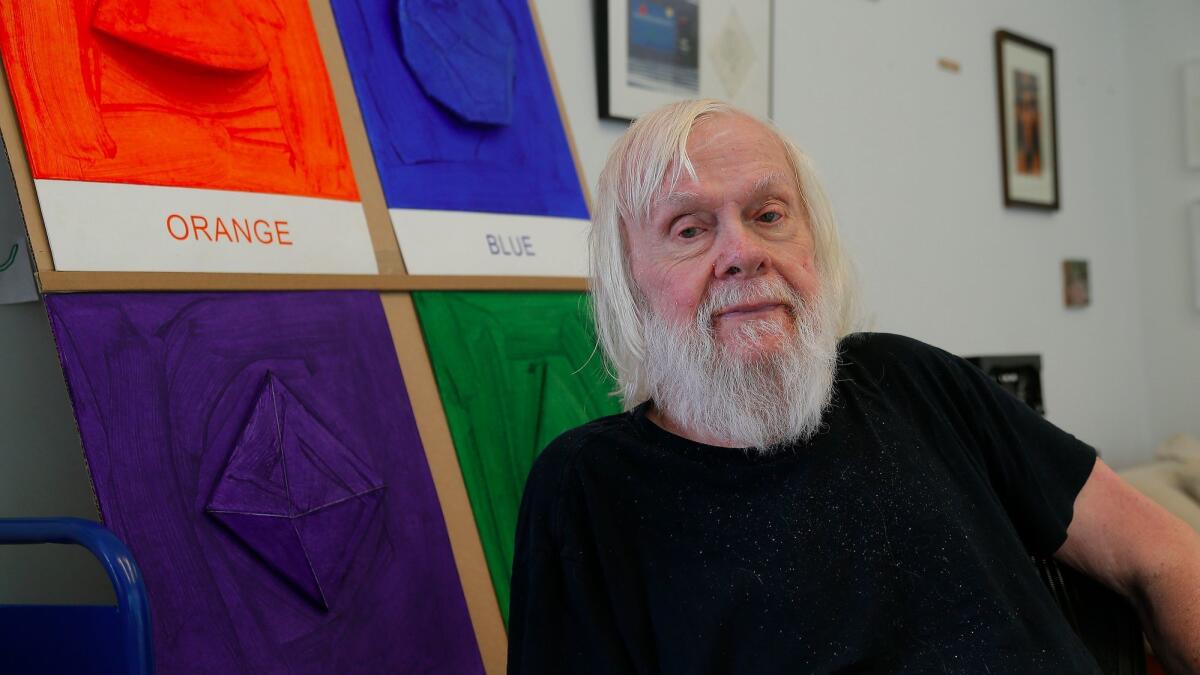
- Share via
Three words: John Baldessari’s desk. It’s a beautifully messy place, a creative vortex of text and imagery that one of his staff members calls a hub for “the brains of the operation” at his L.A. studio. This is where the 85-year-old pioneer of conceptual art sits five days a week, poring over tattered books and thumbing through film stills while searching for snippets of quotes to pair with found imagery he incorporates into paintings.
The desk, a slab of nicked-up plywood over two file cabinets, anchors the office area of his studio, a two-story modernist home in Venice. The building was designed by a student of Frank Gehry’s and has soaring ceilings, stark white walls and light wood floors and glass walls opening to patios. Despite the clean, minimalist environment, Baldessari is not afraid of mess.
“What’s happening?” the artist asks, looking up from behind his desk, which is crammed with jars of raggedy pens, pencils and colored markers. He’s clad in black — a rumpled T-shirt and cargo pants — and sits somewhat slumped, his silver hair hanging loose to his shoulders. He seems uncharacteristically tired today, his hearing not-so-great, and it’s unclear if his question is a casual greeting or a genuine question.
But Baldessari, who will soon retire for a nap on the open futon beside his desk, can be forgiven if he’s a bit weary. He’s been busy. The artist is in the midst of no fewer than five series of prints or paintings in various stages of development. He has a retrospective this November at the Museo Jumex in Mexico City, and he recently completed a work for a survey exhibition, “John Baldessari: Eight Colorful Inside Jobs,” opening at the downtown L.A. print studio Mixografia on Saturday.
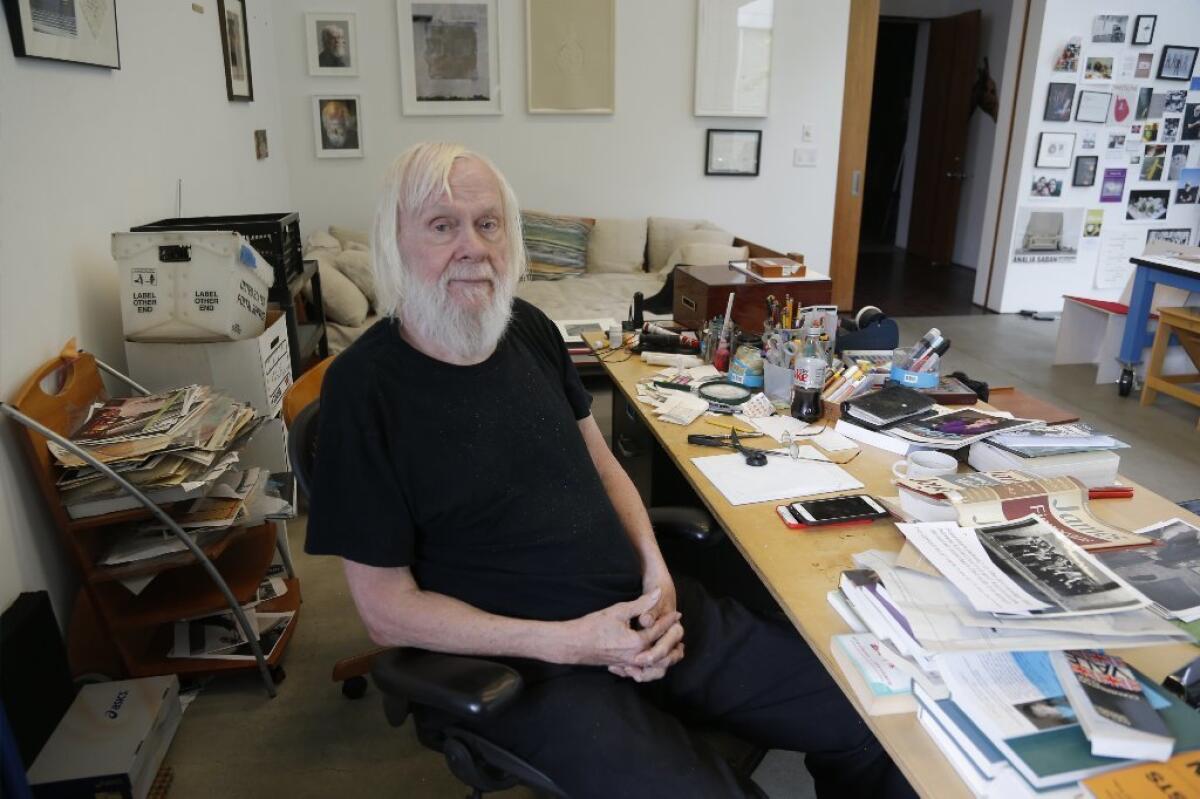
His desk is a testament to this surge of productivity. Piles of tattered books — James Joyce’s “Finnegans Wake,” “The Book of Lists” — are stacked on the table along with scrawled notes, pairs of scissors, a still-fragrant empty coffee mug and two big-screen iPhones. Balled up paper and scraps of magazine cutouts litter the floor around his chair.
“I’m just messy, I don’t put things away,” Baldessari says, matter-of-fact. “I don’t throw things away in my mind, either; I keep them there.”
Baldessari is known for his experimental work blending painting, photography and text — often with wry humor. He pairs black-and-white images, often from old film stills, with words or snippets of dialogue, and he marks the canvas with paint.
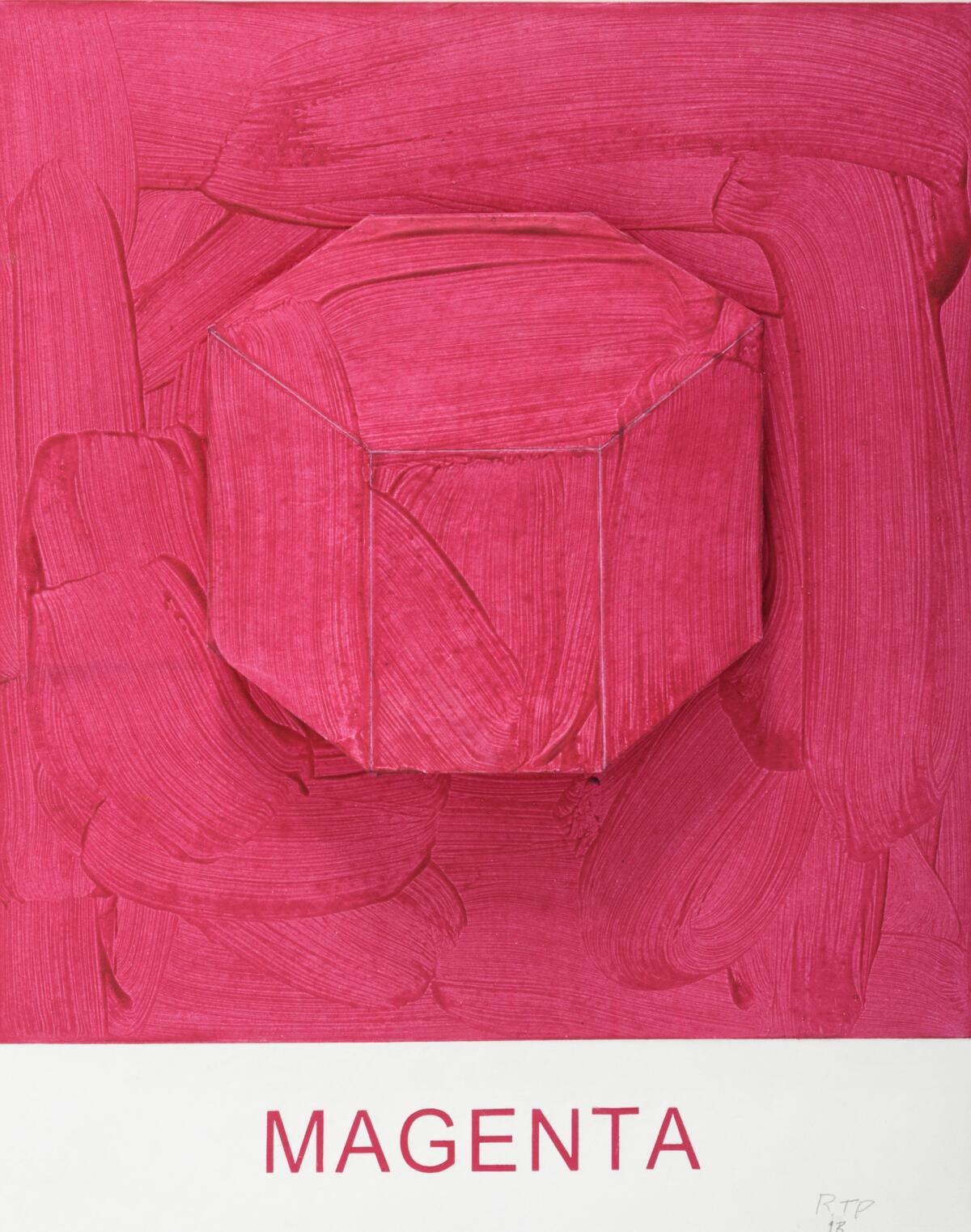
His newest completed body of work, however, is less pop cultural and more art historical. Hanging on the wall are new prints he’s been working on with Mixografia since July. The studio specializes in technology it created, allowing artists to make three-dimensional, sculptural prints on Mixografia’s thick, handmade paper. Baldessari’s new prints are deceptively simple: monochromatic, geometric shapes such as a cube or a diamond that are bathed in saturated, primary colors and named after their hue — “Yellow” or “Purple,” for example. They’re inspired by the 20th century Italian still-life painter Giorgio Morandi, but with a twist. The brush work, typically absent in Baldessari’s work, is especially defined. The jagged sweeps, splotches and upward swooshes are actually sculpted paper protruding from the prints’ surface.
It’s this sort of textural effect that has drawn Baldessari to work with Mixografia for more than 20 years, he says.
“It all stems from being able to make their own paper, that’s what was interesting,” Baldessari says. “They’re the only printmakers I know who can do anything three-dimensional. I give them something I’m interested in doing, and they do it. It’s that simple.”
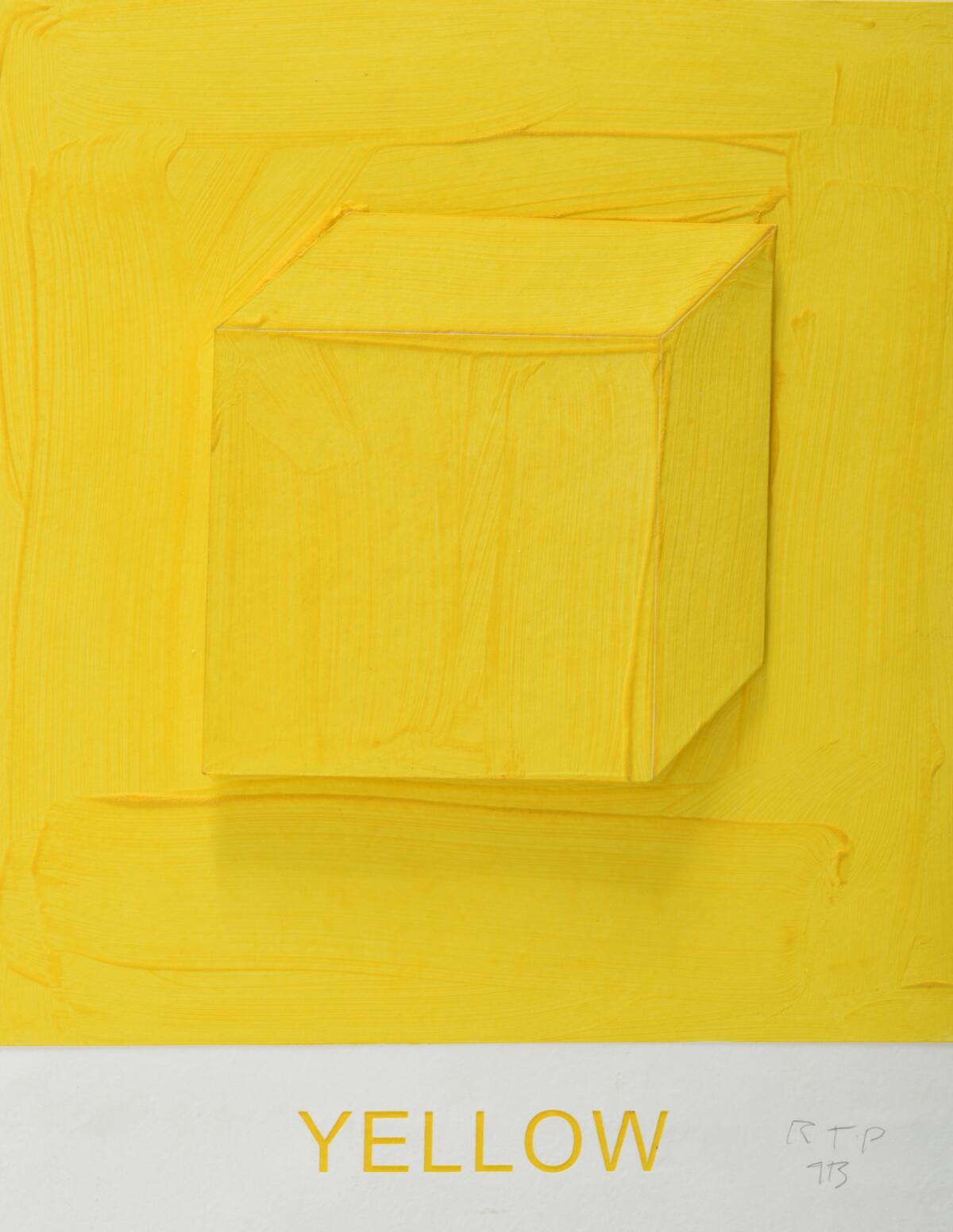
Baldessari has long collaborated closely with Mixografia’s Shaye Remba, who says that the two would regularly meet for lunch to brainstorm new ideas. Baldessari, Remba says, often would arrive with notes and diagrams on engineering paper.
Of this new series, though, Baldessari points at Remba and says: “He made the works!”
Remba balks, immediately interjecting that Baldessari is being modest.
“What has happened, is: He gets an idea — John’s a man of ideas — and he expresses it,” Remba says. “There’s a tight back and forth where we produce models. But it’s John’s vision.”
The upcoming survey show will include everything Baldessari has created at Mixografia over the decades, seven series in all. The first, “Table Lamp and Its Shadow” (1994), was based on Baldessari’s personal collection of swap-meet lamps. Mixografia calls his 2009 “A B C Art (Low Relief): A/Ant, Etc. (Keyboard)” a print in 26 parts, as it humorously illustrates letters of the alphabet. “Concrete Couples,” from 2015, depicts concrete tiles embossed with celebrity footprints, an hommage to the sidewalk in front of the Chinese Theatre on Hollywood Boulevard.
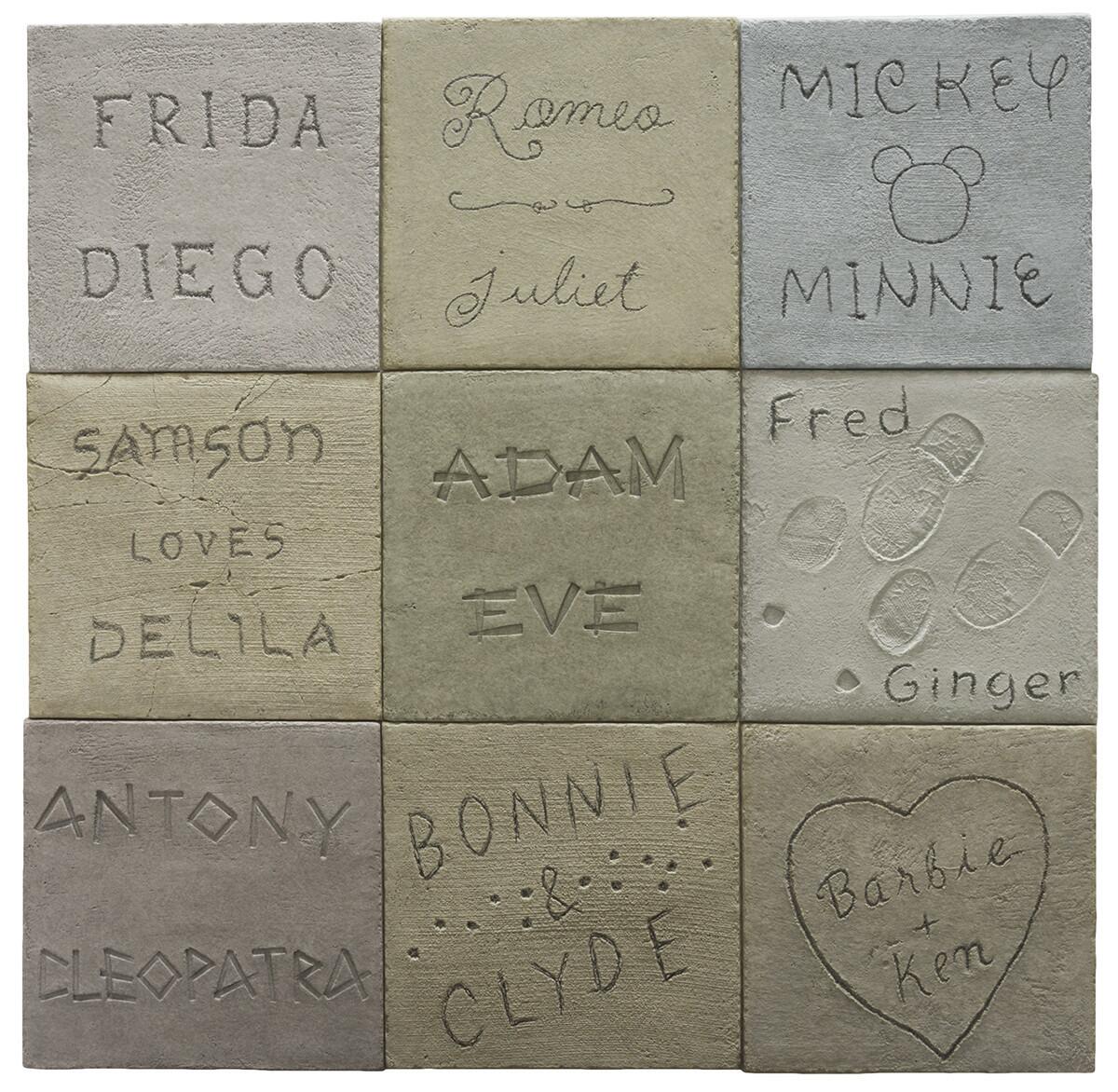
The works are a testament to 23 years of experimentation, not to mention a chance for Baldessari, as he describes it, “to survey the breadth of my thinking.”
In a painting studio adjacent to Baldessari’s office area, more new works line the walls, some of the large canvases still drying. These new series also fit into the historical arc that Baldessari has been mulling of late.
One series, titled the “All Z’s (Picabia/Mondrian),” is based on work by French avant-garde painter Francis Picabia and Dutch painter Piet Mondrian. A single word appears beneath each image, a composite of elements from the artists’ work with Baldessari’s painting on top of it: “Zebra,” “Zeal,” “Zecchino.” The paintings are on their way to Marian Goodman Gallery, which represents Baldessari in New York, with some soon traveling to the Art Basel fair in Switzerland.
Another series is based on emojis. The works feature different animals from the digital pantheon of cutsie symbols: a sneering shark, a plump pig, a spastic-looking gecko.
“How can you not be interested in emojis?” Baldessari asks. “They just look so stupid!”
He’s also beginning a series based on James Joyce, which was inspired by the author’s use of language. “He loves words, I love words,” Baldessari says. “His language is inventive. He makes up words. He’s very creative. It’s fun.”
In 1971, Baldessari famously made a lithograph playing with language. It exclaimed, over and over again in handwritten scrawl, “I will not make any more boring art.”
The scene in Baldessari’s studio is anything but boring. It’s active and layered and tellingly messy. Flat surfaces are blanketed in imagery of all varieties, such as magazine cutouts, personal memorabilia and photographic prints. One wall has a mishmash of personal nostalgia tacked to it: photographs of former students with their young families, postcards and letters from the likes of artists Sol LeWitt and Richard Serra and actress
“It’s just old memories, things I’ve done, people I’ve worked with,” Baldessari says. “Then I clear the wall and start again — when it gets boring.”
Another wall features large-scale images of windmills around the world for a new series based on the novel “Don Quixote de la Mancha.” Each picture of spinning blades features a word at the bottom: “Hmmm” or “As” or “Of.”
“I thought I would do some works of windmills because they’re so useless,” Baldessari laughs. “They don’t do anybody any good, but they’re so symbolic. Of uselessness!”
Baldessari won’t credit anything in particular for inspiring the pace at which he works. “Creative urge, I guess you’d call it,” he says. But he’s appreciative of new exhibitions and the continued interest in his art, globally.
“I feel fortunate. Somebody’s paying attention,” he says of the upcoming Museo Jumex exhibition. “I’m grateful to be influential around the world. People look at what I do. I can’t ask for more than that.”
Then Baldessari reaches into a bag on the floor, rummaging around with his gangly arms before finally pulling out an orange pin he’s made.
“Here, wear it!” he says, handing it over.
It reads: “Stamp out boring art.”
♦ ♦ ♦ ♦ ♦ ♦ ♦ ♦ ♦ ♦
‘John Baldessari: Eight Colorful Inside Jobs’
Where: Mixografia, 1419 E. Adams Blvd., Los Angeles
When: Opening reception 4-7 p.m. Saturday; show runs through July 15
Information: (323) 232-1158, mixografia.com
Follow me on Twitter: @debvankin
ALSO
At LACMA, the horror of 9/11 through the eyes of a Muslim artist who found a different path
Beverly Center as art gallery? How some big-name artists are behind those construction barricades
A groundbreaking show to confront the gender bias in art: 'Women of Abstract Expressionism'
Kerry James Marshall's paintings insist on black self-representation
UPDATES:
4:45 p.m. May 24: This article was updated to clarify the description of the artwork “Concrete Couples.”
The biggest entertainment stories
Get our big stories about Hollywood, film, television, music, arts, culture and more right in your inbox as soon as they publish.
You may occasionally receive promotional content from the Los Angeles Times.








